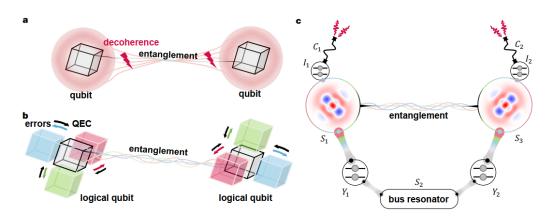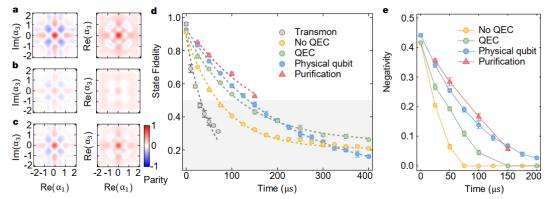Recently, a collaborative research carried out by the teams of Luyan Sun from Tsinghua University, Changling Zou from University of Science and Technology of China, and Haifeng Yu from Beijing Academy of Quantum Information Sciences, achieved the entangled logical qubits protected by quantum error correction within a superconducting quantum system. Their research paper titled "Protecting entanglement between logical qubits via quantum error correction" was published online in Nature Physics on March 6th, 2024.
Quantum error correction is a crucial issue in the field of quantum computing. As is widely known, environmental noise significantly impacts the state of qubits, making quantum computations highly susceptible to errors from external disruptions. Quantum error correction protects quantum information from errors, offering a promising avenue for the practical realization of quantum computing. By introducing redundant degrees of freedom and constructing logical qubits using specific encoding schemes, quantum error correction can identify and correct errors without corrupting the original quantum information.
Currently, the quantum error correction techniques primarily rely on encoding schemes based on multiple two-level qubits, requiring a large number of physical qubits to encode a single logical qubit. This approach faces significant experimental challenges, such as the substantial increase of error channels as the quantity of physical qubits increases, and the need for intricate many-body interactions to detect and correct errors. To overcome these challenges, the research team led by Luyan Sun adopted a different encoding architecture based on single microwave resonators, known as bosonic encoding. This scheme utilizes the infinite Hilbert space of resonators for redundant information encoding while keeping the types of error channels constant, significantly reducing hardware requirements and making it possible to achieve quantum error correction ahead of others.
In recent years, the team of Luyan Sun has been dedicated to research on bosonic quantum error correction. Collaborating with the team of Changling Zou, they were the first to experimentally implement bosonic binomial codes, successfully demonstrating repetitive quantum error correction for logical qubits and extending the lifetime of the corrected logical qubit by 2.8 times than that of its uncorrected counterpart [Nature Physics 15, 503 (2019)]. Subsequently, to enhance the fidelity of error correction operations, they collaborated to develop error-transparent gates for bosonic codes [Nature Physics 16, 827 (2020)]. Building upon this progress, the teams of Luyan Sun and Changling Zou collaborated with the team of Dapeng Yu and Yuan Xu at Southern University of Science and Technology, the team of Shibiao Zheng at Fuzhou University, and the team of Haifeng Yu at Beijing Academy of Quantum Information Sciences. By enhancing the coherence time of the physical qubits and developing a new error detection scheme, they achieved a breakthrough in quantum error correction, beating the break-even point [Nature 616, 56 (2023)]. The critical question for the next step in bosonic quantum error correction is how to extend quantum error correction to multiple logical qubits and achieve protection of the entangled logical qubits.
Recently, Luyan Sun and collaborators achieved a breakthrough in addressing this crucial challenge. By encoding quantum information into spatially separated bosonic modes, they successfully realized entangled logical qubits protected by quantum error correction. This not only demonstrates the significant potential of quantum error correction in protecting quantum information, but also provides an essential technological foundation for practical quantum computing and quantum networks.

Fig. 1 Principle and setup for entangled logical qubits.
Specifically, the research team achieved binomial encoding of logical qubits in two spatially separated bosonic modes, establishing entanglement between the two logical qubits (Fig.1). Different form the entanglement between physical qubits, the entanglement between logical qubits exhibits stronger robustness to local noise, and it can be restored by local quantum error correction operations rather than dissipating directly into the environment. The research team protected entangled logical qubits through repetitive quantum error correction, resulting in a 45% improvement in the coherence time of the entangled logical qubits compared with their unprotected counterparts (Fig.2). Moreover, the research team demonstrated, for the first time, that entangled logical qubits can violate Bell inequalities through error detection and purification (Fig.3).

Fig. 2 Performance of the entangled logical qubits protected by quantum error correction.

Fig. 3 Bell test of the entangled logical qubits.
This breakthrough extends bosonic quantum error correction codes to multiple logical qubits and confirms the feasibility of protecting entangled logical qubits through quantum error correction. This achievement paves the way for universal quantum computing as well as the construction of quantum error correction-protected quantum networks and distributed quantum computing. Also, this accomplishment provides a new experimental platform for verifying fundamental principles in physics.
The first co-authors of the paper are Dr. Weizhou Cai, Dr. Xianghao Mu, and Dr. Weiting Wang from Tsinghua University, with Dr. Weiting Wang from Tsinghua University, Prof. Changling Zou from the University of Science and Technology of China, and Prof. Luyan Sun from Tsinghua University as the corresponding authors. Other contributors include Jie Zhou, Yuwei Ma, Xiaoxuan Pan, Ziyue Hua, Xinyu Liu, Haiyan Wang and Yipu Song from Tsinghua University,and researchers Haifeng Yu and Guangming Xue from Beijing Academy of Quantum Information Sciences.
This work was supported by the National Natural Science Foundation of China, Innovation Program for Quantum Science and Technology, Natural Science Foundation of Beijing, Fundamental Research Funds for the Central Universities, China Postdoctoral Science Foundation, grant from the Institute for Guo Qiang, Tsinghua University and the National Key Research and Development Program of China. This work was partially carried out at the USTC Center for Micro and Nanoscale Research and Fabrication.
For more details, you can find the paper at:https://www.nature.com/articles/s41567-024-02446-8
Editor: Yueliang Jiang
Reviewer: Xiamin Lv